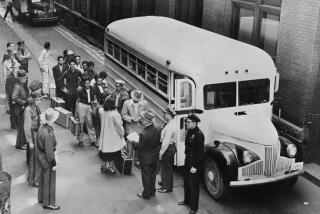Tiny Statue Wields Power in Pacoima
- Share via
The statue of the “patron saint of migrants going to the United States,” as Mexicans affectionately call the Virgin of San Juan de los Lagos, came to a small barrio church in Pacoima this week and thousands who have made the northward journey came to celebrate her visit.
The small wooden figure that, according to legend, was carved in 1629 as a duplicate of another statue of the Virgin Mary that brought a dead girl back to life, came to Guardian Angel Church for three days.
The visit ended a seven-year tour of Catholic parishes in Texas, Illinois, New Mexico, Arizona and California. The statue returns today to Mexico, stopping first in Ensenada before returning to its home in San Juan de Los Lagos in the central Mexican state of Jalisco.
For Guardian Angel, a tiny church that stands in the center of a tough Pacoima housing project, being able to display the statue was a rare privilege. To scores of Latino Catholics, the Virgin of San Juan de los Lagos ranks second in popularity only to the Virgin of Guadalupe, the patron saint of Mexico, said Father Anastacio Rivera of the Archdiocese of Los Angeles.
The local display of the statue was advertised like a rock concert, with posters tacked on telephone poles and taped in the windows of stores throughout Pacoima and San Fernando.
Her arrival was met with parades and outdoor fiestas featuring homemade tamales, round slices of watermelon and snow cones. Religious post cards featuring photos of the statue, posters and special rosaries were on sale outside the church. The festive atmosphere surrounding the statue’s visits, some project residents said, had spilled over into the neighborhood.
“Since La Senora arrived, everything has been different. The evenings have been more peaceful and everyone seems to be happier and more content,” said Lupe Herrera, who lives less than a block from the church.
Priests at Guardian Angel estimated that about 5,000 devotees, some who came from as far as Riverside and San Gabriel, attended special Masses, said several times a day, at which the Virgin’s statue was placed in a nave surrounded by flowers.
It was among Mexicans in Texas that the Virgin acquired the title of patron of immigrants to the United States, said Jorge Martinez, coordinator of the statue’s tour.
“I prayed to her every evening during my travels to this country,” said Maria Sandoval, who was born in Jalisco and now lives in Riverside.
“She protected me then and she holds a special place in my heart. That’s why I’m here.”
The large number of pilgrims who traveled to the Pacoima church to see the statue is not surprising, Rivera said.
‘Foundation of Religion’
“The whole focus of Marian (Virgin Mary) devotion is the foundation of religion in Mexico,” said Rivera. “Bringing Our Lady to Pacoima is a way for immigrants to reconnect with their roots. Literally, it is like mother coming to visit.”
A mixture of history and mythology surrounds the origins of the Virgin of San Juan de los Lagos. As Martinez told the tale:
A Franciscan missionary brought a small figure of the Virgin Mary from Spain in the 1500s and had Indians living in the Jalisco region create their own version out of sugar cane fiber and paste.
After the missionary’s death, the two-foot-high statue was stored and forgotten. Then in 1623, according to the legend, a family of acrobats traveling to Guadalajara stopped in San Juan for an overnight rest. The family was so touched by the town’s hospitality that they offered to perform their circus act as a form of repayment.
Part of the act consisted of the family’s young daughter swinging on a trapeze over a bed of daggers. During the performance, the child fell from the trapeze onto the daggers and was instantly killed.
Brought Back to Life
During the girl’s funeral, a woman brought the statue out of storage and placed it face down on the child’s body. The girl came back to life and the dagger wounds disappeared.
Word of the miracle quickly spread throughout Mexico, Martinez said, and there was such a demand for the statue to be taken to other churches that, in 1629, the people of San Juan carved a second statue. The original remains in San Juan de los Lagos; the second statue came to the Pacoima church.
As worshipers left the church this week, they had to pass the diminutive statue. Some hesitantly touched the figure. Others broke out in tears as they came near.
“I saw her once before when I was a boy and it meant so much to me,” said Miguel Gonzalez, who grew up in Jalisco. “But this time, seeing it at a church near my new home, means so much more to me. I know that I’m never far away from where I was born.”
More to Read
Sign up for Essential California
The most important California stories and recommendations in your inbox every morning.
You may occasionally receive promotional content from the Los Angeles Times.













